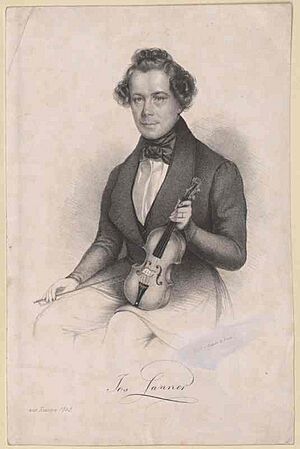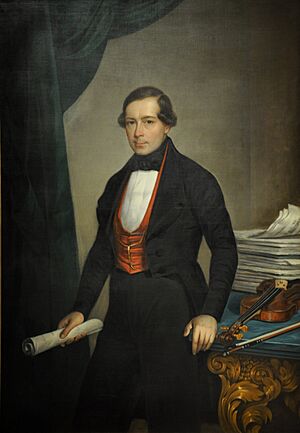Joseph Lanner facts for kids
Joseph Lanner (born April 12, 1801 – died April 14, 1843) was an Austrian composer. He wrote music for dancing and led dance orchestras. He is famous for helping to change the waltz. Before him, the waltz was a simple dance for farmers. Lanner helped make it popular with fancy, high society people. They enjoyed his waltzes for dancing or just for listening.
Lanner was as well-known as his friend and musical competitor, Johann Strauss I. Strauss was more famous outside Austria because he toured in places like France and England.
Lanner had a son named August Lanner. He was also very talented in music, like his father. But he died young at age 20, so his career did not last long. Lanner's daughter, Katharina, became a famous ballet dancer. She moved to London and became an important choreographer (someone who creates dances) and teacher.
Contents
Lanner's Life and Music
Lanner was born in a part of Vienna called St. Ulrich. Today, this area is known as Neubau. He mostly taught himself to play the violin. He joined a small orchestra led by Michael Pamer. Johann Strauss I also joined this group around the same time.
Lanner soon decided to start his own music group. He teamed up with Karl and Johann Drahanek. They formed a quartet (a group of four musicians) that used Lanner's name. This quartet became very popular. Because of its success, it grew bigger. By 1824, Lanner was leading a small orchestra. They played Viennese dance music.
His orchestra was so successful that it played regularly at many Vienna carnivals. These carnivals were known locally as the Fasching. In 1832, Lanner even let Johann Strauss I lead a second, smaller orchestra. This was needed because the carnival schedule was very busy.
Lanner and Strauss: A Friendly Rivalry
By the end of the 1825 carnival season, Lanner was becoming quite famous. Strauss I felt frustrated because he often had to fill in for Lanner. He also felt his own music was not getting enough attention. So, in the same year, Strauss I left Lanner's group. This happened after a concert at a Viennese dance hall called Zum Schwarzen Bock (The Black Ram).
Some news reports at the time said there was a big fight between the two composers. There was even a rumor that Strauss took some of Lanner's best musicians with him. However, these stories were not proven. Lanner had even written a waltz for Strauss called "Trennungs-Walzer" ("Separation Waltz"), Op. 19. This showed that they respected each other's music.
Lanner and Strauss I often worked together even after they split up. In 1826, they even played a benefit concert for their old boss, Michael Pamer, who was sick. This concert was held at the same place where they had separated. For their charity work, Lanner and Strauss also became honorary citizens of Vienna in 1836. They took the Citizen's Oath together.
The people of Vienna loved music and supported both composers. People often called themselves Lannerianer (Lanner's fans) or Straussianer (Strauss's fans). It is believed that the ruling Habsburg family wanted to keep the Viennese people from thinking about politics. Many cities in Europe were getting ready to overthrow their rulers. The Habsburgs thought music and entertainment could distract the people. So, the musical jobs held by Lanner and Strauss became very important.
Lanner himself got a special job. He was named Musik-Direktor (Music Director) of the Redoutensäle (ballrooms) in the Hofburg Imperial Palace. His main jobs were to lead concerts for the nobility (rich and powerful families) and write new music for the Court orchestra.
Lanner's Later Years
In the early 1840s, Strauss's popularity grew even more than Lanner's. Strauss was eager to go on long, profitable tours to other countries, like England. Lanner, however, stayed in Vienna. He was not sure that people in other countries would enjoy Viennese music.
In 1843, Lanner caught typhus, a serious illness that was common in Vienna at the time. He died in Döbling on Good Friday, April 14, 1843. This ended his famous rivalry with Strauss I. Lanner's death marked the start of a time when the Strauss family would be the most important in Viennese dance music for over 50 years. It also ended an exciting time for the waltz and other popular dance music.
Famous Compositions
Lanner wrote many popular pieces. Some of his well-known works include the "Pesther-Walzer," Op. 93, and "Hofballtänze Walzer," Op. 161. Other favorites are "Die Werber" Waltz, Op. 103, and "Die Romantiker" Waltz, Op. 167.
His most famous work is probably "Die Schönbrunner" Walzer, Op. 200. This was likely the most famous waltz before "The Blue Danube" by Johann Strauss II in the mid-1860s. Many of Lanner's waltzes were dedicated to important noble families. This was part of his job at the time. His "Styrian Dances" (Steyrische-Tänze), Op. 165, are sometimes played at the Vienna New Year's Concert by the Vienna Philharmonic Orchestra.
List of Works
- "Neue Wiener", Ländler (New Viennese), Op. 1
- "Trennungs-Walzer", waltz (Separation), Op. 19
- "Amoretten", waltz, Op. 53
- "Die Humoristiker", waltz (The Humorists), Op. 92
- "Pesther-Walzer", Op. 93
- "Abschied von Pest", waltz (Farewell from Pest), Op. 95
- "Die Werber", Op. 103
- "Marien-Walzer", (Maria Waltz), Op. 143
- "Malapou", galop, Op. 148
- "Hofballtänze", waltz (Royal Court Dances), Op.161
- "Steyrische Tänze" (Styrian Dances), Op. 165
- "Die Romantiker", waltz (The Romantics), Op.167
- "Hans-Jörgel", polka, Op. 194
- "Die Mozartisten", waltz, Op. 196 (based on music from the operas of Wolfgang Amadeus Mozart)
- "Die Schönbrunner", waltz, Op. 200



